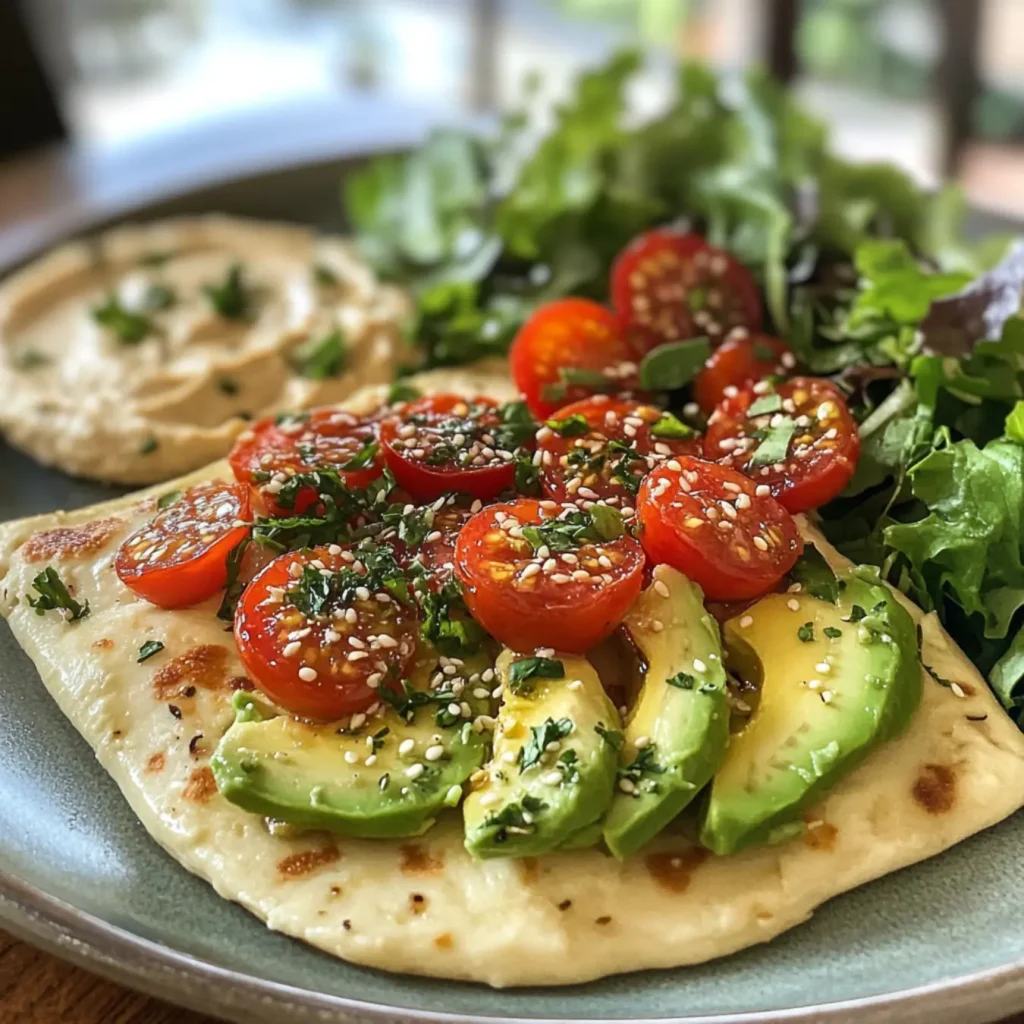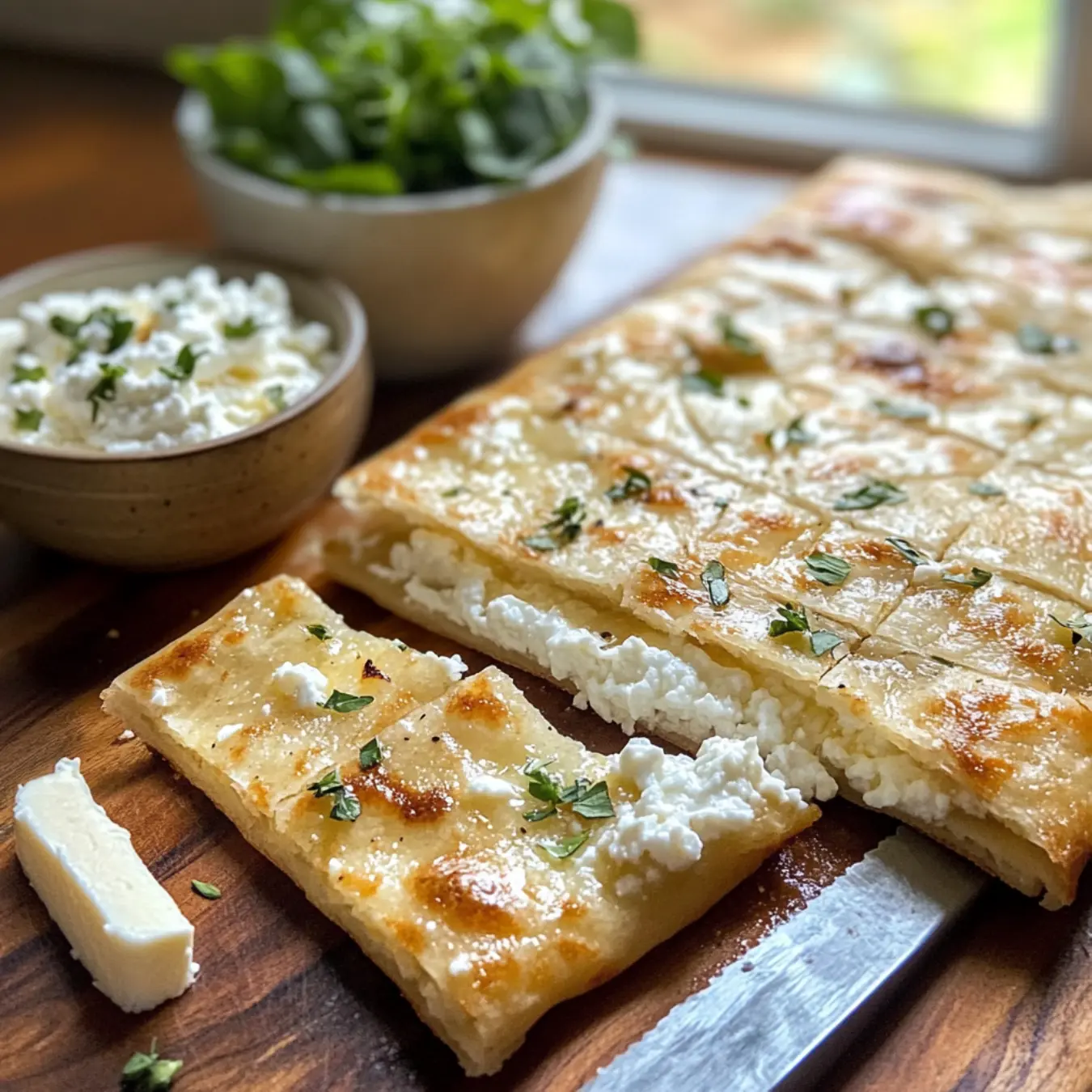A simple and healthful substitute for conventional flatbread is this Soft & Protein-Packed Cottage Cheese Flatbread. Perfect for wraps, sandwiches, or dips, this flatbread made with creamy cottage cheese is soft and high in protein. Above all, it’s ready in just twenty minutes!
Table of Contents
The Reason You Will Love This Recipe
- High-protein and nutrient-dense cottage cheese gives suppleness and a boost of protein.
- Fast and easy; ready in only twenty minutes using basic materials.
- Customize it with herbs, garlic, or spices for a better taste.
- Versatile; top like a pizza, dip it in hummus, or wrap it.
Want more ways to enjoy cottage cheese in meals? Check out these Cottage Cheese Recipes!
Ingredients
You will need the following for this delicate and fluffy flatbread:
- Blended smooth for a creamy, high in protein basis, cottage cheese.
- The basis of the dough is either whole wheat flour or all-purpose flour.
- Adds lightness and facilitates puffing with baking powder.
- Salt sharpens taste.
- Olive oil softens and plugs the dough.
- Water: Added as necessary to attain the proper consistency.
- Optional garlic powder gives a subdued, flavorful dimension.
- For a hint of herbs, drizzle dried oregano or Italian seasonings.
- The recipe card underneath has full ingredient measurements.
👉 The complete ingredient list with measurements is in the recipe card below!
Making Cottage Cheese Flatbread: Techniques
First: Smooth the cottage cheese.
- Blend cottage cheese till smooth and creamy in a food processor or blender.
Second: Create the dough.
- Combine in a big basin of flour, baking powder, salt, garlic powder, and dried oregano. Add the blended cottage cheese, olive oil, and a drizzle of water.
Third step: work the dough.
- Stir until soft dough results. If the dough seems too dry, knead for two to three minutes, adding extra water as needed.
Step 4: Divide and roll.
Roll each 4–6 pieces of dough into a thin, level circle.
Step five: prepare the flatbread.
- Set a non stick skillet or griddle to medium heat. Cook each flatbread on each side for one to two minutes to become golden brown and somewhat puffed.
Sixth step: present and savor.
- Brush olive oil or butter, then present warm alongside hummus, dips, or as a sandwich wrap!

Looking for healthy baking ideas? Check out these Healthy Baking Recipes!
Advice on Perfecting the Recipe
- Use a hot pan to get a soft but chewy texture and golden brown patches.
- Don’t overwork the dough; knead only until smooth to maintain tenderness.
- Make it gluten-free by substituting a mix for all-purpose flour.
- Add more herbs and spices; consider rosemary, thyme, or chili flakes for added taste.
Serving techniques
- The perfect accompaniment for a snack or appetizer is hummus or dip.
- Toss grilled chicken, vegetables, or falafels in a soft wrapper as a wrap.
- As a side for soups and stew, it is a fantastic substitute for regular bread.
- Drizzle extra virgin olive oil and sprinkle with feta or Parmesan using Cheese & Olive Oil.
Need more topping inspiration? Try these Apple Breakfast Recipes!
Make Ahead and Organization for Storage
Managing Leftovers
Store baked flatbreads refrigerated for up to five days, or keep them at room temperature in an airtight container for two days.
Slowing down
Plastic wrap each flatbread separately, then keep it in a freezer-safe bag for up to two months. Reheat in an oven or on a skillet.
Repetition
Reheat for five minutes in a 350°F oven or thirty seconds per side in a hot skillet.

Ask questions here.
Could I create gluten-free flatbread?
Indeed. Substitute a gluten-free flour blend for all-purpose flour.
How should one obtain a soft texture?
Cook on a medium-hot skillet for a smooth yet somewhat crisp texture; avoid over-kneading the dough.
Is Greek yogurt a substitute for cottage cheese?
Indeed. Though the texture may differ slightly, Greek yogurt can be used in place.
Could I bake this rather than on a skillet?
Of course! Bake until golden, 8 to 10 minutes, at 375°F (190°C).
Conclusion
Perfect for wrapping, dipping, or matching with your favorite foods, this soft, protein-packed cottage cheese flatbread is a substitute for standard flatbread. Delicious, quick, simple enjoy! 🍞✨

Cottage Cheese Flatbread
Equipment
- Food Processor or Blender
- Mixing Bowl
- Rolling Pin
- Non-Stick Skillet or Griddle
Ingredients
Main Ingredients
- 1 cup cottage cheese
- 1 1/2 cups all-purpose flour or whole wheat flour
- 1 tsp baking powder
- 1/2 tsp salt
- 1 tbsp olive oil
- 1/4 cup water as needed
Optional Seasonings
- 1/2 tsp garlic powder optional
- 1/2 tsp dried oregano or Italian seasoning optional
Instructions
- Blend the Cottage Cheese: In a food processor or blender, blend cottage cheese until smooth and creamy.
- Make the Dough: In a large bowl, mix flour, baking powder, salt, garlic powder, and dried oregano. Add the blended cottage cheese, olive oil, and a splash of water.
- Knead the Dough: Mix until a soft dough forms. Knead for 2-3 minutes, adding water as needed if the dough is too dry.
- Divide & Roll: Divide dough into 4-6 pieces and roll each into a thin, flat circle.
- Cook the Flatbread: Heat a non-stick skillet or griddle over medium heat. Cook each flatbread for 1-2 minutes per side until golden brown and slightly puffed.
- Serve Warm: Brush with olive oil or butter and serve with dips, hummus, or as a sandwich wrap!

